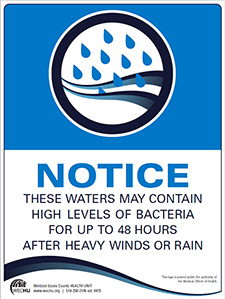Each year during the warmer months (June – September), Public Health Inspectors perform a weekly beach safety assessment and water quality assessment at eight local public beaches. Water samples are tested for E. coli bacterial counts. For E. coli results, call our Beach Hotline at 519-258-2146 ext. 1490 or visit the beach water testing page.
- Don’t go swimming if you can’t see your feet underwater when you’re standing in waist deep water.
- Don’t go swimming if the water is rough, cloudy or green.
- Don’t swim for at least 48 hours after a heavy rainfall or wind.
- Look for drainage pipes at the beach and avoid swimming near them.

Weather conditions are the leading factors that affect water quality.
Bacteria levels elevate with an increase in rain and with the strength of the wind blowing onto the shore. Rainwater washes fecal material from cats, dogs, birds, and other wildlife into storm sewers which flow directly into nearby rivers and lakes. We recommend that you don’t swim for at least 48 hours after a rainfall, or if the water is cloudy. Calm, clear water is usually associated with lower bacterial levels, while rough or cloudy water often means higher levels of bacteria.
Certain types of bacteria found in water can cause a number of illnesses. The most common are stomach and intestinal illnesses such as vomiting and diarrhea, along with lung, eye, ear, nose, or throat infections or skin issues. Swallowing contaminated water is the main way you may get sick.
Bacteria can also enter the body through the ears, eyes, nose, or through broken skin.
Physical hazards are also a possible danger when swimming in polluted water. If water isn’t clear, objects like rocks and broken glass are much less visible and more likely to cause injury. If you can’t see your feet underwater when you’re standing in waist deep water, you should not go swimming.
There are many sources of water pollution, including chemical and biological pollutants from factories, farms, boats, marinas and city streets. In rare cases, the Medical Officer of Health may order a beach closure due to a chemical or other hazardous spill.
Always look for drainage pipes at the beach and avoid swimming near them. These pipes drain polluted water from streets and may end up in the beach water.
- Always pick up your animal’s waste. Pet waste is a major source of bacteria in water.
- Don’t use soap in the beach water as it feeds the algae and bacteria.
- Don’t litter. Throw your waste in the receptacles.
- Dispose of human waste in a sanitary manner.
- Do not feed or leave out food to attract animals or birds as they leave droppings.
- Do not go in the water if you have an infection or an open wound.
- Ensure your septic system is in good working order.
In agricultural areas:
- Fence animals away from streams and give them other sources of water.
- Ensure feedlot and manure pile runoff is properly contained.
If you think a beach is contaminated, contact us at 519-258-2146 ext. 4475. It is important that we know about suspected beach water contamination, so we can help protect you from harmful exposure. If you think you may have become ill from beach water, be sure to see your health care provider.
Don’t forget about Sun Safety when you’re at the Beach.
Here are some tips on how to protect yourself:
- From April to September in Canada when the UV Index is 3 or higher, protect your skin.
- From 11 am to 3 pm limit your time in the sun.
- Stay in the shade as much as possible. If there isn’t any shade, create your own with umbrellas.
- Wear a wide-brimmed hat to protect your head, face, ears and back of neck.
- Wear sunglasses or prescription lenses with full UVA and UVB protection at all times when in the sun.
- Wear tightly woven clothing.
- Generously apply sunscreen that is SPF 30 or higher and is labelled ‘broad spectrum’ and ‘water resistant'.
- Put sunscreen on all exposed skin 20 minutes before you go out.
- Reapply when required (read the label) especially after swimming, strenuous exercise or toweling off.
- Consider using sunscreen lip balm (30 SPF) for lips.
References
- Government of Canada (2024) Canadian recreational water quality guidelines - Indicators of fecal contamination
- Health Canada. (2012). Guidelines for Canadian recreational water quality, 3rd edition.
- Health Canada. (2023). Sun Safety.
- Ontario Ministry of Health and Long-Term Care. (2019). Recreational Water Protocol. Toronto, ON: Queen’s Printer for Ontario.
- Ontario Ministry of Health and Long-Term Care. (2018). Operational Approaches for Recreational Water Guideline. Toronto: ON: Queen’s Printer for Ontario.
- United States Environmental Protection Agency. (2016). Beaches.

